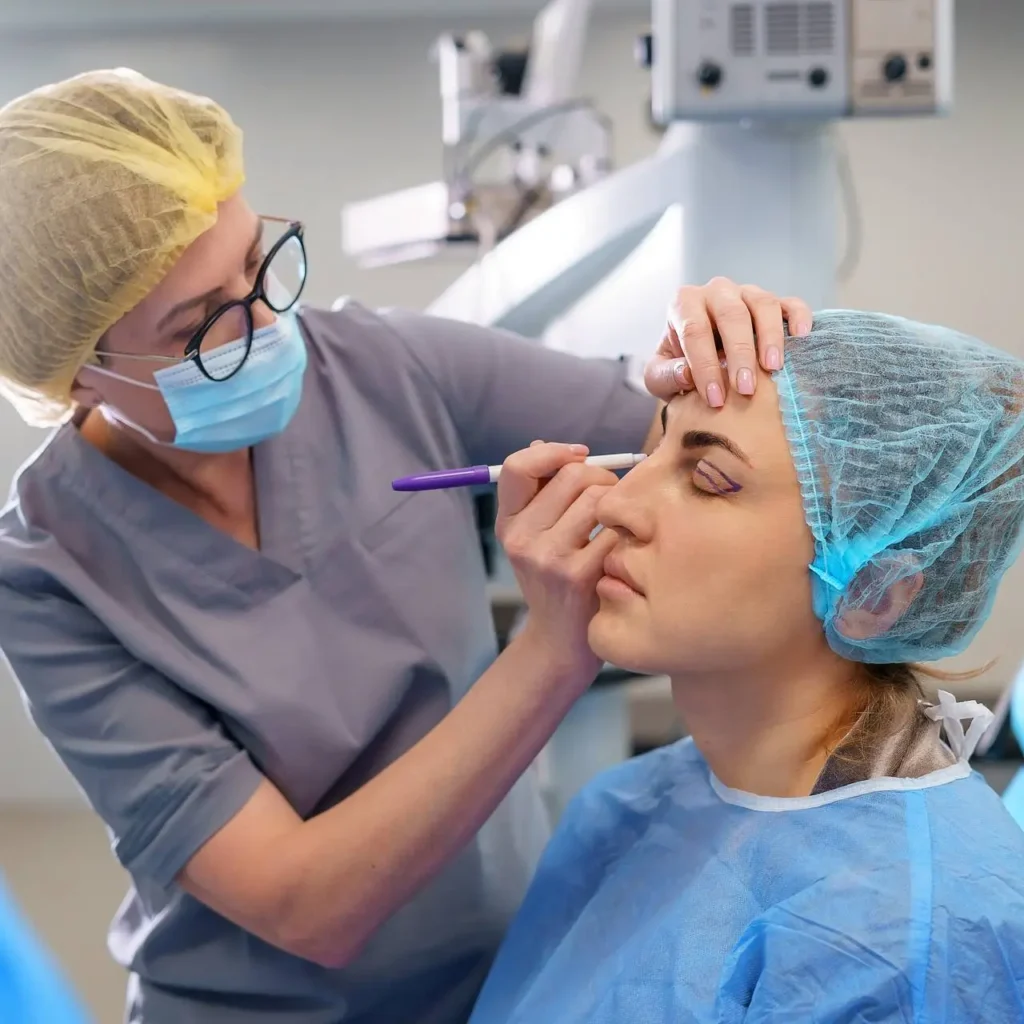Key Takeaways
- Ozempic face is when patients taking Ozempic lose facial volume and skin gets loose.
- Plastic surgeons help with Ozempic face by offering treatments like fillers and surgery.
- Working together with other doctors is key to helping patients with Ozempic face.
- It’s important for plastic surgeons to be ethical and teach patients about this new issue.
- New studies and trends are changing how plastic surgery handles Ozempic face.
What is Ozempic Face?
The term “Ozempic face” has become popular lately. It refers to the loss of facial volume and sagging skin some people get from Ozempic. This happens because the drug causes fast weight loss, changing how the face looks.
Defining the Phenomenon
Ozempic face makes a person look sunken and gaunt. The cheeks, temples, and other face areas lose fullness. This makes the skin sag, giving a more aged look.
The amount of facial volume loss varies. It depends on how well the body reacts to the drug and how fast weight is lost.
Causes and Contributing Factors
The main reason for Ozempic face is the fast weight loss it causes. Ozempic works by making more insulin and reducing hunger. This leads to a lot of weight loss for some users.
As fat and muscle are lost, the face’s tissue depletes. This results in a sunken look.
Other things also play a part. Age, skin elasticity, and health can make Ozempic face more noticeable. Older people and those with loose skin are more likely to see big changes.
It’s important to understand Ozempic face for doctors and those taking the drug. By tackling this side effect, they can help manage weight and improve facial appearance better.
The Role of Plastic Surgeons
Plastic surgeons are key in the world of aesthetic medicine. They help with the unique facial issues caused by Ozempic face. These experts have the skills and experience needed to rejuvenate the faces of those affected.
They play a big role in figuring out what each patient needs. They create special treatment plans to tackle Ozempic face’s various problems. This includes fixing lost facial volume and skin laxity, using both surgery and non-surgery methods.
Evaluating Facial Concerns
The first thing plastic surgeons do is check the patient’s face and concerns. They do a detailed assessment to find out what’s causing Ozempic face. This helps them make a treatment plan that fits the patient’s needs.
Comprehensive Treatment Strategies
Plastic surgeons have many solutions for Ozempic face. They use everything from injectable fillers to facelifts. They pick and mix different methods to get the best results for their patients.
| Treatment Approach | Description |
|---|---|
| Injectable Fillers | Restoring lost facial volume by strategically injecting dermal fillers to plump up sunken areas and redefine facial contours. |
| Fat Grafting | Utilizing the patient’s own fat to augment and rejuvenate the face, providing a natural and long-lasting solution. |
| Facelift Procedures | Surgical techniques that address skin laxity and repositioning underlying facial structures for a more youthful appearance. |
| Non-Surgical Skin Tightening | Advanced technologies, such as radiofrequency or ultrasound, that stimulate collagen production and tighten the skin without the need for invasive surgery. |
Working with plastic surgeons opens up many facial rejuvenation options for those with Ozempic face. They can find a solution that meets their specific needs and goals.
Addressing Facial Volume Loss
As the Ozempic face phenomenon continues to impact patients, plastic surgeons have developed specialized techniques. They use injectable fillers and fat grafting procedures to address facial volume loss.
Injectable Fillers
Injectable fillers, like hyaluronic acid-based products, are a popular choice. They are used to restore facial volume. These treatments are minimally invasive and can make the face look younger and more rejuvenated.
Plastic surgeons skilled in using these fillers can deliver the right amount to specific areas. This meets the unique needs of each patient.
Fat Grafting Techniques
Fat grafting is another effective solution. It involves taking the patient’s own fat tissue from areas like the abdomen or thighs. Then, it’s carefully transferred to the face where volume is lost.
The natural fat tissue restores volume and enhances facial contours. This provides a natural and sustainable result.
By combining these innovative approaches, plastic surgeons can effectively address the challenges posed by Ozempic face. They help patients regain their desired facial appearance and confidence.
Rejuvenating Skin Laxity
Plastic surgeons are finding ways to deal with the sagging skin caused by Ozempic face. They use both surgical facelifts and non-surgical skin tightening. Each method has its own benefits for a younger look.
Facelift Procedures
Facelifts, or rhytidectomy, are surgeries for sagging skin on the face and neck. They tighten muscles and remove extra skin. This makes the face look more defined and youthful.
Plastic surgeons tailor facelifts to fit each patient’s needs. They aim for a natural look that highlights the patient’s features.
Non-Surgical Skin Tightening
For those who don’t want surgery, there are non-surgical options. Treatments like radiofrequency, laser, and ultrasound work by heating the skin. This stimulates collagen and tightens the skin without surgery.
These methods are good for mild to moderate skin sagging. They can work well with fillers or fat grafting.
By mixing surgery and non-surgery, plastic surgeons can help patients with Ozempic face look younger. They tackle both volume loss and skin sagging for a full solution.
Preventive Measures and Maintenance
Plastic surgeons help patients deal with Ozempic face issues. They offer tips on how to prevent and maintain results. This advice lets people manage Ozempic face effects and keep their treatments looking good.
Changing your lifestyle is a big part of prevention. Plastic surgeons suggest eating well, drinking plenty of water, and exercising regularly. These habits help keep your skin healthy and prevent it from sagging.
Creating a good skincare routine is also important. Plastic surgeons recommend using gentle, nourishing products that fit your skin type. This includes moisturizers, serums, and sunscreen to protect your skin from harm.
Going back to your plastic surgeon for check-ups is key. Regular visits and any needed tweaks help keep your look natural and balanced. It’s important to talk to your surgeon about any changes or worries you have.
- Adopt a balanced, healthy lifestyle with a focus on nutrition, hydration, and exercise
- Establish a personalized skincare routine with guidance from your plastic surgeon
- Maintain regular follow-up appointments for monitoring and any necessary adjustments
“Preventive measures and ongoing maintenance are key to achieving and sustaining the best results from Ozempic face treatments. By working closely with their plastic surgeons, patients can proactively manage the effects of this phenomenon and maintain their rejuvenated appearance.”
Plastic Surgeons Ozempic Face: A Comprehensive Approach
Plastic surgeons lead the fight against Ozempic face. They use a mix of surgeries and non-surgeries to help their patients. This all-encompassing method is key to tackling this facial issue.
At the heart of their strategy is understanding Ozempic face’s causes. They see it as a mix of volume loss, skin sagging, and changes in face shape. This knowledge helps them craft a treatment plan that meets each patient’s needs.
- Comprehensive assessment of facial anatomy and aesthetics
- Personalized treatment plans that combine multiple modalities
- Collaboration with other medical professionals for an interdisciplinary approach
Plastic surgeons use many methods, like fillers, fat grafting, facelifts, and non-surgical tightening. They use their skill and creativity to add volume, tighten skin, and refresh the face’s look.
“Addressing Ozempic face requires a meticulous and thoughtful approach, with the patient’s unique needs at the forefront of the treatment plan,” explains Dr. Jane Doe, a renowned plastic surgeon specializing in facial rejuvenation.
They also focus on educating patients and working with other doctors. They team up with endocrinologists, dermatologists, and others for a complete care plan.
As research on Ozempic face grows, plastic surgeons stay ahead with new solutions. Their all-inclusive approach aims to boost patients’ confidence and tackle this facial issue’s unique challenges.
Patient Education and Awareness
As plastic surgeons face the rise of Ozempic face, teaching patients and spreading awareness is key. This part looks at how doctors talk to patients, set clear goals, and help them choose the right treatments.
Good patient education is the first step in tackling Ozempic face. Doctors need to explain why this condition happens, like how Ozempic can affect face shape and skin tightness. They should talk openly to clear up any confusion.
It’s also important to set realistic hopes. Doctors should walk patients through their options, like fillers, fat grafts, facelifts, and non-surgical tightening. This helps patients make choices that fit their needs and wants.
Plastic surgeons also have a big role in making people aware of Ozempic face. They share their knowledge through workshops, interviews, and resources for patients. This helps remove the stigma and encourages people to get help.
In the end, patient education and awareness are key for plastic surgeons dealing with Ozempic face. By talking openly, setting clear goals, and teaching the public, they help patients tackle this issue with confidence and reach their beauty goals.
Collaboration with Medical Professionals
Plastic surgeons team up with endocrinologists and dietitians to tackle Ozempic face. This teamwork is key to solving the complex issues Ozempic can cause.
Interdisciplinary Care
Together, they create special treatment plans. These plans tackle the hormonal and nutritional issues behind Ozempic face, along with the looks. This team effort means patients get a full, effective care plan.
- Endocrinologists check and fix hormonal imbalances that cause facial volume loss and other side effects.
- Nutritionists and dietitians help develop diets and lifestyle changes to lessen Ozempic’s cosmetic effects.
- Physical and occupational therapists help patients regain facial muscle tone and look younger.
This collaborative approach lets plastic surgeons use their colleagues’ skills. They offer interdisciplinary care that improves patients’ lives and results.
“Addressing Ozempic face requires a multidisciplinary effort, with plastic surgeons working closely with other medical professionals to deliver tailored, comprehensive care.”
Ethical Considerations
As plastic surgeons explore the trend of Ozempic face, they face many ethical implications. This unique facial issue requires careful thought and ethical action from medical experts.
One major concern is informed consent. Patients must know the risks and benefits of treatments for Ozempic face. Plastic surgeons need to have open and detailed talks with their patients.
Choosing the right patients is another big issue. Not everyone with Ozempic face is a good candidate for treatment. Surgeons must carefully check each patient’s health and situation before deciding on treatment.
Setting the right expectations is also crucial. Plastic surgeons must balance hope with realistic results. They need to explain the treatment’s possibilities and limits clearly to their patients.
By focusing on ethical considerations, plastic surgeons can prioritize their patients’ well-being. This approach builds trust and leads to positive results for their patients.
Emerging Trends and Research
The field of plastic surgery is always changing. New techniques and technologies are coming up to tackle Ozempic face challenges. Researchers and plastic surgeons are looking into new ways to rejuvenate faces, focusing on solutions for those affected by this condition.
Advanced imaging technology, like 3D scanning and simulation tools, is becoming more common. These tools help plastic surgeons understand the unique facial changes caused by Ozempic face. This allows them to create personalized treatment plans, ensuring each patient gets the best care.
Research is also looking into stem cell-based therapies and regenerative medicine. These treatments aim to use the body’s natural healing to address volume loss and skin laxity in Ozempic face. They could offer long-lasting, natural-looking results for patients.
At Global News Empire, the Medical category delves into the latest advancements and trends in healthcare and wellness.
Whether you’re interested in the latest medical technologies, wellness tips, or developments in regenerative treatments, the Medical category at Global News Empire brings you up-to-date, actionable insights from trusted sources.
FAQ
What is Ozempic face?
Ozempic face is when people lose facial volume and skin sagging from Ozempic. This happens because the drug causes fast weight loss. It can make the face look hollow or older.
What causes Ozempic face?
Ozempic face comes from fast weight loss from the drug. As fat is lost, the face’s volume and skin under it shrink. This makes the face look sunken or gaunt.
How can plastic surgeons help address Ozempic face?
Plastic surgeons offer many treatments for Ozempic face. They use injectable fillers, fat grafting, facelifts, and non-surgical tightening. These help patients look younger and more refreshed.
What injectable fillers can be used to treat Ozempic face?
Plastic surgeons use fillers like hyaluronic acid to add volume. They place these fillers in areas where volume is lost. This makes the face look more balanced and youthful.
How can fat grafting techniques help with Ozempic face?
Fat grafting takes fat from one body area and injects it into the face. It’s a way to restore volume and improve facial shape. It’s effective for Ozempic face.
What surgical options are available for Ozempic face?
For those with a lot of skin laxity and volume loss, facelifts are recommended. These surgeries tighten and lift the skin. They also restore volume and shape to the face, offering lasting results.
Can non-surgical skin tightening treatments help with Ozempic face?
Yes, treatments like radiofrequency or ultrasound can tighten skin. They’re non-invasive and help with sagging skin. They’re a good option without surgery.
What preventive measures can patients take to manage Ozempic face?
Plastic surgeons suggest preventive measures and maintenance. This includes lifestyle changes and regular skincare. Following up with the plastic surgeon is also important.













